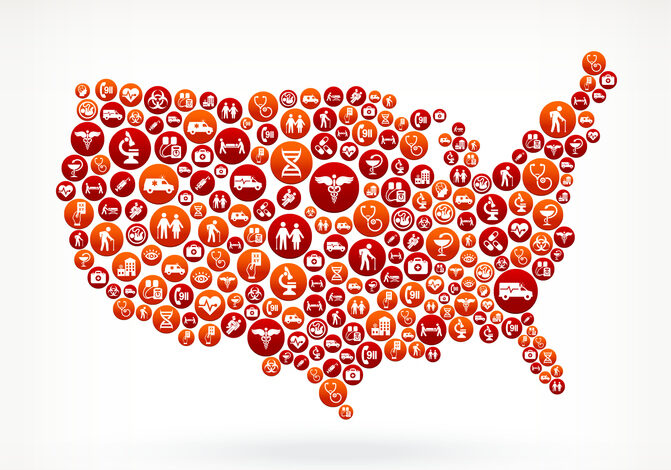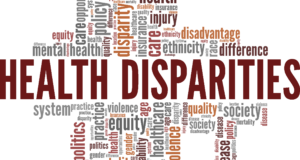
Your Zip Code, Your Health
BY ANNIE GARDINER, MS
Social determinants of health (SDOH) are non-medical factors that influence health outcomes—that is, they are environmental conditions in which people are born, learn, live, work, play, worship and age that affect health and quality-of-life outcomes (ODPHP, 2020).
Social determinants of health include access to
- Good jobs
- Clean water and air
- Public transportation
- Quality affordable housing
- Safe streets and neighborhoods
- Emergency and health services
- Quality education
- Economic stability
- Healthy food
- Voting
Contrary to common understanding, neither individual behavior, genetics nor clinical care are the primary determinants of health outcomes. Instead, we must look toward our social, economic and political fabric to understand why two people in two different zip codes have dramatically different life expectancies.
Meet Amy and Luisa
Amy is 63 years old and lives in the United States postal code 94611. Luisa is also 63 and lives in postal code 94621. Amy’s average life expectancy is 82.4 years and Luisa’s is 75.2 years (RWJF, 2020). They live in the same city, just nine miles apart. How can their life expectancies be so different?
Access to Healthy Food
Both Amy and Luisa have Type 2 diabetes, but their access to healthy food and healthcare is vastly different. When diagnosed with diabetes, Amy is able to adjust her weekly grocery shops to include fresh vegetables, replace processed grains with whole grains, purchase unsweetened yogurt and complement lean meat proteins with legumes. Amy could hop into her car and drive 1.2 miles to a grocery store.
Luisa, on the other hand, lives 4.2 miles away from a grocery store – and does not own a vehicle. She lives in a “food desert,” an area in which residents have few or no options for buying affordable and healthy food – especially vegetables and fruits. Instead, Luisa has to find her food in neighborhood convenience stores and fast-food restaurants, which sell processed foods and put residents at a higher risk of diabetes and obesity.
Approximately 39.5 million people in the United States (12.8% of the population) live in food deserts, urban and rural combined (Annie E Casey Foundation, 2021). When identifying food deserts, researchers consider distance to a grocery store, income and the availability of transportation. Food deserts are more common in areas where residents have lower incomes, lower levels of education and higher rates of unemployment.
Access to Quality Education
Seventy-eight percent of the students in Amy’s local elementary school are proficient in reading. In contrast, 42% of the elementary school students in Luisa’s neighborhood are proficient in reading (California Department of Education, 2021). The difference in reading proficiency impacts healthcare literacy including a patient’s understanding about medical conditions, treatment options, prevention programs and medication labels and directions.
Access to Transportation
Amy’s numbers have become slightly elevated over time, and her doctor prescribes Metformin, a first-line oral medication for diabetes. She has private insurance, and her local pharmacy, 1.2 miles away, carries the medication.
Luisa’s diabetes is not yet well controlled, and she’s been prescribed insulin. Her pharmacy is also 1.2 miles away and it does accept Medicaid, but bus service has been unreliable – and it’s worse with the COVID 19 pandemic. Getting to the pharmacy is also challenging with her variable shift work schedule; as a result, Luisa occasionally runs out of both insulin and glucose monitoring supplies. Luisa is also waiting to meet with a diabetes educator, but there is only one in a 50-mile radius.
Access to Emergency Services
One evening, Luisa reports that her heart is racing; she’s unusually tired, super thirsty and is a bit off balance. Could this be a diabetes-related matter or a cardiac situation? Her daughter calls 911, and the EMT assesses the situation and takes Luisa to the city’s general hospital, which is 7.2 miles away. On the other hand, should something go awry for Amy, she’s only 4.8 miles from her hospital.
Access to Primary Care
Once stabilized, Luisa is released and told to see her primary care physician within two weeks to discuss her diabetes management plan. Luisa is on Medicaid and the next appointment is six weeks from now. Amy, on the other hand, is typically able to get an appointment within one to two weeks.
Proximity to Pollutants
While the effect of asthma on diabetes is only proven to be significant with severe asthma, it is well understood that asthma prevalence increases as income decreases (CDC, 2020). Amy lives 9.2 miles away from the freeway trucking route, and Luisa lives 1.8 miles away.
Stress
The stress of living with poverty and racism takes a toll on the human psyche and body. Adrenaline increases heart rate and blood pressure, and cortisol increases glucose in the bloodstream. Stress makes it harder to sleep, and lack of sleep makes it harder to control diabetes.
Socioeconomic Status & Access
Health is very much tied to socioeconomic status, and, put simply, people are healthier in the absence of poverty. In fact, income, education and occupation show a graded association with diabetes prevalence and complications across all levels of socioeconomic status; that is, diabetes prevalence increases as income decreases (Hill-Briggs, 2020).
Returning to Amy and Luisa, 20% of the students in Amy’s local elementary school are low income and, in contrast, 94% in Luisa’s. (California Department of Education, 2021).
The root causes of illness and poverty are the same. By conservative estimates, healthcare inequities cost the U.S. health system $320 billion per year – and if we don’t start addressing systemic racism, poverty and gender inequities, that figure could rise to $1 trillion by 2040 or $3,000 per American per day (Gordon, 2022).
How Did We Get Here?
When examining inequities, it’s necessary to look at history, law and economic policy.
A key historical driver for generating the persistent inequities we see between Amy and Luisa’s health experiences is redlining. Redlining was a 30-year discriminatory practice in which mortgage lending services were denied to residents in specific geographic locations based on race and ethnicity. These practices prevented residents from owning homes and building intergenerational wealth and led to rampant divestment in communities – which were then further isolated by “not in my backyard” freeway construction.
The ramification of redlining is still being felt decades later, as the distribution of COVID-19 hospitalizations and deaths illustrates. Luisa’s zip code was redlined for decades, and it had the third highest number of cumulative COVID cases in a city of 450,000 residents (Treuhaft, 2020).
Care Manager as Agent of Change
Care managers have an important role in assessing for and addressing social determinants of health in client/patient services – and a crucial role in creating systemic change that amplifies the health and well-being of historically marginalized communities.
Here are some actions you can take as care managers:
- Examine your care management assessment questions to capture the community factors affecting your client’s health and well-being. Explore transportation, food sourcing, affordability of medications, healthcare access and other environmental conditions.
- Educate yourself on best practices in health literacy using resources on the CDC website. (https://www.cdc.gov/socialdeterminants/faqs/index.htm).
- Amplify the needs and voices of people in your communities who have been historically marginalized by volunteering on policy and legislative efforts to create systemic change. Push on these levers: food, transportation, housing, healthcare access and health insurance policy.
- Deepen community partnerships to build more holistic models of services.
- We all have implicit bias. Become aware of the stereotypes you hold – and replace them with accurate information. Build your awareness by taking Harvard’s Implicit Bias Tests. (https://www.projectimplicit.net).
Conclusion
Type 2 diabetes is a chronic metabolic disease that occurs when the pancreas does not produce enough insulin or when the body cannot effectively use the insulin it produces. Patients benefit from lifestyle changes (diet and exercise), monitoring and medication. But individual behavior and clinical care only tell one part of the story. Social determinants of health, which are linked to socioeconomic status, are a strong predictor of diabetes onset and progression (Hill-Briggs, 2020).
Rather than ask individuals to adapt to inequities, care managers have an opportunity to mitigate barriers and challenge the root causes of socioeconomic inequities.
References
Annie E Casey Foundation (2021) Food Deserts in the United States. Retrieved from https://www.aecf.org/blog/exploring-americas-food-deserts
California Department of Education (2021) California School Dashboard. Retrieved from https://www.caschooldashboard.org/
Center for Disease Control (2022) Most Recent National Asthma Data. Retrieved from https://www.cdc.gov/asthma/most_recent_national_asthma_data.htm
Gordon, D. (2022) Health Inequities Could Cost the U.S. Health System $1 Trillion by 2040. Forbes. Retrieved from https://www.forbes.com/sites/debgordon/2022/06/23/health-inequities-could-cost-the-us-health-system-1-trillion-by-2040-new-report-says/?sh=77fe57291ba9
Hill-Briggs, F., Adler N. E., Berkowitz S. E., Chin, M. H., Gary-Webb, T. L., Navas-Acien, A., Thorton, P. L., Haire-Joshu, D. (2020) Social Determinants of Health and Diabetes: A Scientific Review. Diabetes Care 2020; 44(1):258–279. https://doi.org/10.2337/dci20-0053
Office of Disease Prevention and Health Promotion (2020) Social Determinants of Health. Retrieved from https://www.healthypeople.gov/2020/topics-objectives/topic/social-determinants-of-health
Robert Wood Johnson Foundation (2020) Life Expectancy: Could Where You Live Influence How Long You Live? Retrieved from https://www.rwjf.org/en/library/interactives/whereyouliveaffectshowlongyoulive.html.
Treuhaft, S., McCullough, E., Ramiller, A., (March 2020) Which Bay Area Communities Are Hit Hardest by the COVID-19 Pandemic. Bay Area Equity Atlas. Retrieved from https://bayareaequityatlas.org/research/COVID_ZIPs

Annie Gardiner, MS, is a retired health care advocate. She is a public speaker and is committed to building racial equity in healthcare advocacy. For more information, email [email protected].




